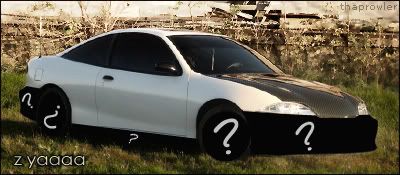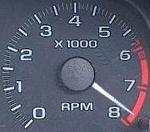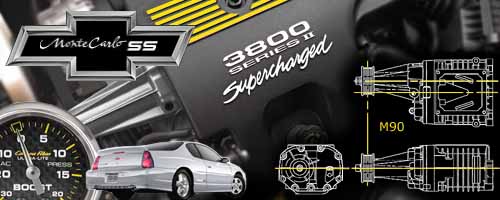http://www.youtube.com/watch?v=dyR0U_fYtwY#7I-7oOF26QI
This is odd, a leafblower actually making gains on the dyno.
I know that the leafblower is plugged into the wall, and not drawing off the battery like the E-ram, but it makes me wonder.
The E-ram is supposedly 900+cfm and a leaf blower/ bilge blower is around 200-300cfm.
Maybe the video is rigged, who knows...
2003 Sunfire with a 2 1/4 inch turbo muffler, 2 1/4 piping to a 2 1/2 inch resonator (bigger to make up for the baffling), a 2 1/4 inch catalytic converter, 2 1/4 inch down-pipe, a ported LSJ manifold, a drop in K&N filtercharger and sports a Bomber body kit with a VIS Invader hood.
hmmm....very interesting! does make you wonder if the ebay fan does work attached to your intake.

I was thiknin about one of them but it just seems too sketchy for me.
OMG! you'd better get one now!

Riddle me this... riddle me that...
ohh it works alright..naaaag
Built&Boosted moar
04 Cavalier Turbo r.i.p my baby
2nd place 2009 GM tuner bash qwick 8--holla
It should be noted that the leaf blower being used in the vid isn't electric. It's a Stihl gas-powered commercial model, the type lawn maintenance guys use (I should know from that summer I worked for Mr. Delordo). They move way more air than any electric job can! At a velocity of 200mph, no less.
Go beyond the "bolt-on".
Nickelin Dimer wrote:It should be noted that the leaf blower being used in the vid isn't electric. It's a Stihl gas-powered commercial model, the type lawn maintenance guys use (I should know from that summer I worked for Mr. Delordo). They move way more air than any electric job can! At a velocity of 200mph, no less.
Mine is electric and does 210MPH.
Anyways,
THEY DON'T @!#$ WORK
2001 Olds Alero (LD9)
650 whp / 543 ft-lb
@turboalero
Even if what they did actually worked, you would need 120V (about 3-400lbs of extra batteries) and a 12" blower (where is that gonna fit?)
I doubt it could push more air than the natural vaccum of the pistons anyway. well the e-bay ones

Nickelin Dimer wrote:It should be noted that the leaf blower being used in the vid isn't electric. It's a Stihl gas-powered commercial model, the type lawn maintenance guys use (I should know from that summer I worked for Mr. Delordo). They move way more air than any electric job can! At a velocity of 200mph, no less.
Um, most of, if not all, commercial leafblowwers are gas, backpack styles.
Caution: I have an odd sense of humor, so don't be offended by the things I say

MMMM, HIDs

whiteboyz24 wrote:Even if what they did actually worked, you would need 120V (about 3-400lbs of extra batteries) and a 12" blower (where is that gonna fit?)
Can we stop acting like AC current is the same as DC?
A good 12v blower designed well will push just as much air as anything else. ITs all in the design...
Granted I hope you like running two 0awg wires directly from your battery to your little mystery device that barely nets any gain but...It theoretically has nothing to do with voltage. Learn your basic Ohm's laws...

Buildin' n' Boostin for 08' - Alex Richards
Alex Richards wrote:whiteboyz24 wrote:Even if what they did actually worked, you would need 120V (about 3-400lbs of extra batteries) and a 12" blower (where is that gonna fit?)
Can we stop acting like AC current is the same as DC?
A good 12v blower designed well will push just as much air as anything else. ITs all in the design...
Granted I hope you like running two 0awg wires directly from your battery to your little mystery device that barely nets any gain but...It theoretically has nothing to do with voltage. Learn your basic Ohm's laws...
well then you design one and show me that it works.
waiting...................
(Heh, heh, heh.) This is sooooo reminding me of "Mad Max" & "My Science Project".
Go beyond the "bolt-on".
Just to expand on what Alex is talking about^^, The deal with electricity in terms of voltage & amperage is as follows:
As voltage increases, amperage draw goes down. The same is vice-versa when reversed (Voltage: Down = Amperage Draw: Up!). And as the draw increases the factor of resistance (Ohms) becomes a bigger part of the picture, and heavier wires & cables become necessary to deliver current without incurring too much resistance. Remember "Big Three" wires? Same thing only more so & truly necessary. I mean, why do you think one of the leads to the starter are so heavy? The same gauge increase rule applies when trying to deliver electricity of a certain voltage & current draw over a increasing distance.
A fine example of this would be electric cars. Because the motor(s) used to propel them draw so much current to initially get them moving, the designers/builders have two choices as to how they shall make it in terms of operating system voltage, which will effect what gauge cable or wire they must use. Going 12v & wiring the batteries in parallel (Positive->positive, negative->negative) will demand a heavy gauge of wire to handle the current draw that would add weight (Something they try to steer clear of for the sake of operating range) that may not exist, and be very costly if it did. Or they could wire the batteries in series (Positive->negative) to create 120v, and the level of draw would require a wire of lesser gauge to be used & keep cost and weight down. This is the very same reasoning that pushed the big auto corporations to switch from building their cars from using a 6v system (Pretty much anything built until shortly after WWII) to a 12v system.
Now, about mid-to-late last decade there was talk about all the big auto companies possibly moving towards making cars with a 42VDC system. There was alotta speculation as to what the advantages would be to do so & why, but at the time nobody outside the engineering centers figured it would be cause of the development of hybrid cars (Stay with me now!). Why? Because a 42v system would require less current to be drawn to turn the motor, and a smaller, lighter battery & cables could be used to make it (Remember: Big corporations don't do anything unless they must, and if they do, it will be for the most profit or least cost). Funny how that worked out.
Now that's been settled, let's move-on to the AC/DC thing that few here understand...
The reason why AC is so popular for household is because years ago it was discovered that DC has a problem with maintaining voltage (Or was it amperage?) when fed over long distances (Think miles, not feet). It would require boosting stations every so many miles just to keep it up, and they were costly. This is where Westhouse's Alternating-Current shined. By causing the polarity (Positive & Negative) to alternate at a frequency of 60 cycles a second (or 60hz) the output of the power station could be maintained over greater distances, with lesser gauge of cable to deliver it (There's that cable/resistance thing again). But since automotive systems rely upon stored current (A battery) to be drawn directly to supply electricity to start the engine, and it is of a non-alternating type because it's impossible to store the other way, automobile electrical systems are designed to operate upon DC (Direct-Current).
Now I know you're asking "Why does my car have an alternator if it operates on DC?". Simple: Because DC generator requires an increasing of size to up the amperage output to a certain level, it was found easier to design a AC generator that contained diodes (Electrical "Valves" that allowed current to pass only one-way through them) for rectification to create a DC output of the same or greater amperage level with a smaller case.
Go beyond the "bolt-on".
^^^^ Winner winner chicken dinner ^^^^^
One big problem that was an issue in the axe for 42vdc is arcing however. Its a big problem especially when we are talking about carrying around a trunk full of lithium polymer batteries. This is why the push is more for 24vdc systems.
I believe the problem solved by westinghouse (with the help and support of nikola tesla) was the voltage loss and obvious cluttering of independant DC circuits. (think one power cable running to EVERY house individually instead of being able to network them like we do now.
AC current at a much higher voltage also allows us to use alluminum core conductors which make large spans over water and high tension power lines possible because of reduced weight (The alluminum conductor would yield much to high a resistance in a DC circuit as well as needing to be over twice the size that they are currently. Same with copper only copper is of course heavier.)
on 120v leg in a DC circuit (+ or - as amperage is the same throughout a dc circuit) lets assume for the application a wire needs to be an inch in diameter (core thickness)
a 120v leg in an AC circuit (Ground NEutral or Hot) that same wire need not be more than 1/4" Still a HUGE wire, but you get the idea.
DC to AC generator explanation, Also right on the money, shall I post up a schematic of a GM voltage regulator circuit and see if anyone figures it out? haha
Diode trio anyone?
Interesting to note that that supercharger is only pulling about 12 amps while running. If i'm reading the DVOM right? I saw it spike but its hard to see where the decimal point is.

Buildin' n' Boostin for 08' - Alex Richards
Thank you Alex for helping me by expanding on what I was saying & providing the clarity it needed that I could not give it! And you are so right about how aluminum is cheaper yet higher in resistance. And how copper (Outside of gold-plated lead) is the best conductor for the money, as expensive as it is. That was something my Auto Electrical instructor (A former "Mr. Norm" serviceman) taught me back in my high-school Career Education Center days. Shame that the auto corporations can't embrace Li-Po (Lithium-Polymer) batteries like the R/C-car market has, but again, remember the corporate rules (Damn them!). And how 'bout a big round of applause for The Diode Trio? They helped revolutionize the way DC is made. And let's not forget the ol' O/V/R math rule while we're at it. It's something that most don't seem to appreciate. But then, it's math. And sadly, most folks don't seem to get it these days.
BTW, when can I expect my coupon for Popeye's? I sure could go for some spicy strips, now that you mentioned chicken. I so love deep-fried white-meat w/hot spices.
Go beyond the "bolt-on".
Oh yeah, you're also right about the arcing resultant from use of 42v as opposed to 12-24v (Think sparkplug, folks. After all... What do does the ignition coil do to get the electricity to jump that gap? Right...!).
Go beyond the "bolt-on".
Yes, unfortunately even my instructors are telling us that "we'll never use ohms law" in the field and such...sad.. because it really is a fundamental tool and a great one to have in the back of your head as your troubleshooting.
mmm fried chicken...

Buildin' n' Boostin for 08' - Alex Richards
^Or just building a system. Knowhadamean?
Go beyond the "bolt-on".
yes, and for that matter...building anything electrical.
IT opens alot of doors.
Watts law is another one...handy for "I just bought these awesome new bulbs! they are so much brighter but why do i keep blowing bulbs and fuses?"

Buildin' n' Boostin for 08' - Alex Richards
I'll hafta review that one, as it's been a while since I've done anything electrical, and the "tools" are starting to rust, as you can see. No, wait... Never-mind, I just remembered it in relation to the driving/fog lamp upgrade I did a short while ago (55w->100w).
Go beyond the "bolt-on".





 MMMM, HIDs
MMMM, HIDs




